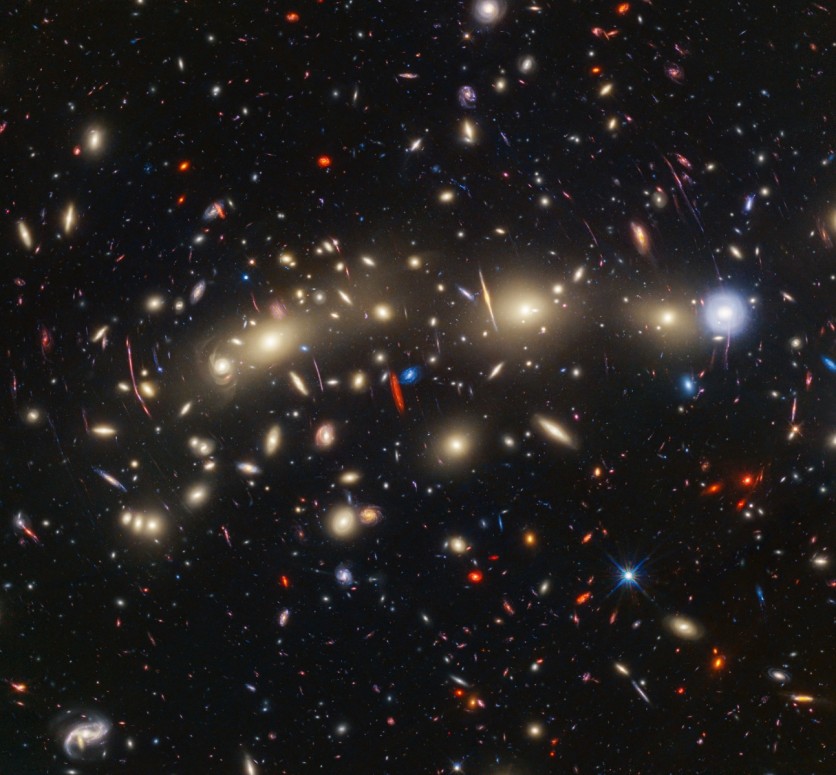Two of NASA's most powerful space telescopes have joined their cosmic forces to unveil the most colorful view of the universe!

(Photo : NASA, ESA, CSA, STScI, Jose M. Diego (IFCA), Jordan C. J. D'Silva (UWA), Anton M. Koekemoer (STScI), Jake Summers (ASU), Rogier Windhorst (ASU), Haojing Yan (University of Missouri))
The comprehensive view of the MACS0416 galaxy cluster combines infrared observations from NASA's James Webb Space Telescope with visible-light data from NASA's Hubble Space Telescope. The image color-coded the shortest wavelengths of light as blue, the longest as red, and the intermediate wavelengths as green.
The MACS0416 Galaxy Cluster
NASA's James Webb Space Telescope and Hubble Space Telescope have collaborated to capture a stunning and comprehensive image of the MACS0416 galaxy cluster, providing one of the most detailed views of the universe to date.
Situated approximately 4.3 billion light-years away, MACS0416 comprises colliding galaxy clusters that are set to merge and form an even larger cluster in the future.
Thee resulting panchromatic image reveals intricate details, showcasing galaxies both within and beyond the cluster through the combination of visible and infrared light.
This collaboration between the two telescopes has enabled the capture of sources displaying varying brightness over time, potentially influenced by gravitational lensing-a phenomenon where light from distant sources is distorted and amplified.
The Frontier Fields program, an ambitious collaborative effort by the Hubble Space Telescope, commenced with MACS0416 as its first target. Hubble's contributions involved detecting some of the faintest and youngest galaxies ever observed, while Webb's infrared capabilities added a deeper perspective to this exploration of the early universe.
The image employs color-coding, with the shortest wavelengths represented in blue, intermediate in green, and the longest in red, resulting in a vibrant representation of galaxies across a broad range of wavelengths, from 0.4 to 5 microns.
This color spectrum not only enhances the aesthetic appeal but also provides insights into the distances of galaxies, as explained by NASA.
The bluer galaxies, closer and often displaying intense star formation, are predominantly detected by Hubble, while the redder galaxies, indicative of greater distance, are primarily identified by Webb. Some galaxies appear extremely red due to high levels of cosmic dust absorbing bluer colors of starlight.
Read Also : New Computer Simulation Sheds Light on Early Galaxy Formation Aligned With NASA James Webb's Observations
Identifying Transients
While the collaborative observations contribute to the visual allure, they serve a scientific purpose, aiming to identify transients - objects that exhibit changes in brightness over time. The research team detected 14 transients within the field of view, with 12 located in three highly magnified galaxies through gravitational lensing.
These transients are likely individual or multiple-star systems undergoing brief, intense magnification. The remaining two transients, found in moderately magnified background galaxies, are believed to be supernovae.
One standout transient among the identified ones is "Mothra," located in a galaxy that existed about 3 billion years after the big bang. Mothra, magnified by at least 4,000 times, showcases both extreme brightness and magnification.
Hubble's observations taken nine years earlier captured Mothra's visibility alongside another magnified star named "Godzilla," presenting a fascinating astronomical puzzle. The team proposes the presence of an additional, faint object within the foreground cluster acting as a lens, but its true nature remains unknown.
Related Article : NASA's James Webb Space Telescope Captures Evidence of Carbon Dioxide, Methane on Larger-Than-Earth Exoplanet





